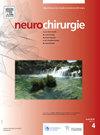显微外科入路与血管内治疗颅颈交界处动静脉瘘:系统回顾和荟萃分析。
IF 1.4
4区 医学
Q4 CLINICAL NEUROLOGY
引用次数: 0
摘要
颅颈交界处动静脉瘘(ccjavfs)是一种罕见且复杂的血管病变,对诊断和治疗提出了重大挑战。尽管神经影像学有所进步,但最佳治疗策略仍存在争议。本系统综述和荟萃分析旨在比较显微手术与血管内入路治疗CCJ房颤的安全性和有效性。方法:系统检索PubMed、Embase、Web of Science、Cochrane Library,检索截止至2024年3月。如果研究报告了显微手术或血管内治疗CCJ AVFs的结果,包括神经系统改善、完全闭塞、复发和并发症,则纳入研究。采用随机效应荟萃分析综合数据,采用I²统计量评估异质性。结果:纳入7项研究,共451例患者(显微外科:n = 348;血管内:n = 103)。与血管内治疗相比,显微手术在神经系统改善方面没有统计学上的显著优势(OR = 2.10, 95% CI: 0.83-5.31, p = 0.5651, I²= 0%)。显微手术组的完全闭塞率明显高于对照组(OR = 11.93, 95% CI = 2.12 ~ 66.97, p = 0.0049; I²= 70.6%)。复发率差异无统计学意义(OR = 0.22, 95% CI: 0.02 ~ 2.81, p = 0.2416)。总体并发症相似(OR = 0.63, 95% CI: 0.09-4.62, p = 0.0007, I²= 79.1%),尽管显微手术的缺血性并发症明显较少(OR = 0.23, 95% CI: 0.07-0.70, p = 0.0104)。死亡率也具有可比性(RR = 1.87, 95% CI: 0.28-12.66, p = 0.5213, I²= 25.9%)。结论:显微手术具有较高的闭塞率和较少的缺血性并发症,总体结果支持个体化治疗方案。本文章由计算机程序翻译,如有差异,请以英文原文为准。
Microsurgical approach versus endovascular treatment of craniocervical junction arteriovenous fistulas: A Systematic Review and Meta-analysis
Introduction
Craniocervical junction arteriovenous fistulas (CCJ AVFs) are rare and complex vascular lesions that pose significant diagnostic and therapeutic challenges. Despite advances in neuroimaging, optimal treatment strategies remain controversial. This systematic review and meta-analysis aimed to compare the safety and efficacy of microsurgical versus endovascular approaches for treating CCJ AVFs.
Methods
A systematic search of PubMed, Embase, Web of Science, and Cochrane Library was conducted up to March 2024. Studies were included if they reported outcomes of microsurgical or endovascular treatment for CCJ AVFs, including neurological improvement, complete obliteration, recurrence, and complications. Data were synthesized using a random-effects meta-analysis, and heterogeneity was assessed using the I² statistic.
Results
Seven studies with 451 patients were included (microsurgery: n = 348; endovascular: n = 103). Microsurgery showed no statistically significant advantage in neurological improvement compared to endovascular treatment (OR = 2.10, 95% CI: 0.83–5.31, p = 0.5651, I² = 0%). Complete obliteration rates were significantly higher in the microsurgical group (OR = 11.93, 95% CI = 2.12–66.97, p = 0.0049; I² = 70.6%). Recurrence rates did not differ significantly (OR = 0.22, 95% CI: 0.02–2.81, p = 0.2416). Overall complications were similar (OR = 0.63, 95% CI: 0.09–4.62, p = 0.0007, I² = 79.1%), although microsurgery had significantly fewer ischemic complications (OR = 0.23, 95% CI: 0.07–0.70, p = 0.0104). Mortality rates were also comparable (RR = 1.87, 95% CI: 0.28–12.66, p = 0.5213, I² = 25.9%).
Conclusion
Microsurgery offers higher obliteration rates and fewer ischemic complications, while overall outcomes support individualized treatment planning.
求助全文
通过发布文献求助,成功后即可免费获取论文全文。
去求助
来源期刊

Neurochirurgie
医学-临床神经学
CiteScore
2.70
自引率
6.20%
发文量
100
审稿时长
29 days
期刊介绍:
Neurochirurgie publishes articles on treatment, teaching and research, neurosurgery training and the professional aspects of our discipline, and also the history and progress of neurosurgery. It focuses on pathologies of the head, spine and central and peripheral nervous systems and their vascularization. All aspects of the specialty are dealt with: trauma, tumor, degenerative disease, infection, vascular pathology, and radiosurgery, and pediatrics. Transversal studies are also welcome: neuroanatomy, neurophysiology, neurology, neuropediatrics, psychiatry, neuropsychology, physical medicine and neurologic rehabilitation, neuro-anesthesia, neurologic intensive care, neuroradiology, functional exploration, neuropathology, neuro-ophthalmology, otoneurology, maxillofacial surgery, neuro-endocrinology and spine surgery. Technical and methodological aspects are also taken onboard: diagnostic and therapeutic techniques, methods for assessing results, epidemiology, surgical, interventional and radiological techniques, simulations and pathophysiological hypotheses, and educational tools. The editorial board may refuse submissions that fail to meet the journal''s aims and scope; such studies will not be peer-reviewed, and the editor in chief will promptly inform the corresponding author, so as not to delay submission to a more suitable journal.
With a view to attracting an international audience of both readers and writers, Neurochirurgie especially welcomes articles in English, and gives priority to original studies. Other kinds of article - reviews, case reports, technical notes and meta-analyses - are equally published.
Every year, a special edition is dedicated to the topic selected by the French Society of Neurosurgery for its annual report.
 求助内容:
求助内容: 应助结果提醒方式:
应助结果提醒方式:


